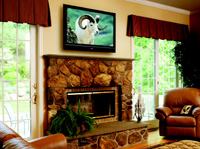In less than two years, the transition to digital TV will be a done deal. For anyone shopping TVs today, the question isn’t whether you’ll buy an HDTV but which type, format, and feature set you’ll choose. Consumers used to just pick a screen size and style. These days you have to pick from an alphabet soup of technologies, too: DLP, D-ILA, LCD, and plasma for starters and then projector or standalone TV to boot.
All the options are good news for homeowners seeking to fit TVs into various rooms in the house. Today’s custom home could well house several different types of TVs depending on the room and the application. Flat-panel TVs may be all the rage, but customers will always prefer the cinema-like experience of a projector system in the home theater. An affordable rear-projection TV might be the best option for a family room where homeowners don’t want to commit to a full-blown installation. An LCD TV might be the preferred choice over plasma for above the fireplace because its lighter weight requires less bracing.
Manufacturers are doing their part to make HDTV too good to pass up. Price wars at the end of 2006 sent consumers scurrying to stores in search of $1,000 42-inch plasma TVs, a price not fathomable a few short years ago. And TVs today simply fit better in a room. Design is as much a part of the engineering process as picture quality and features. Flat displays are no longer a marketing craze but the holy grail of TV design. The big bulky rear-projection tube TV of the past will soon be a relic of the analog age. Not all TVs are flat panels, but competing technologies had better be thin if they want to take on plasma and LCD.
There are a few things homeowners need to know about their TV choices over the next few years. Flat-panel TVs will expand into new and larger screen sizes to meet a variety of placement options. Panasonic held 2006 bragging rights with the largest flat-panel TV—a 103-inch plasma model that sells for roughly $60,000. Sharp Electronics wants the trophy this year and plans to deliver a 108-inch LCD TV during 2007.
An alternative to plasma and LCD is Digital Light Processing (DLP), a technology based on Texas Instruments components and built to the specs of TV makers including Samsung, Toshiba, Mitsubishi, LG, and others. DLP TVs tend to be larger and less expensive than their flat-panel counterparts. Mitsubishi’s DLP TVs, for instance, measure 52-, 57-, 62-, 65-, and 73 inches.
DLP TVs are shallower and much lighter than the old CRT tube TVs, but they still require a fair share of floor space. A 56-inch Samsung DLP set, for instance, measures 17 inches deep. But DLP technology doesn’t require the glass tubes of old rear-projection sets, making them lightweight for their size. For those wanting to mount a TV in a cabinet, the 84-pound weight is extremely manageable.



